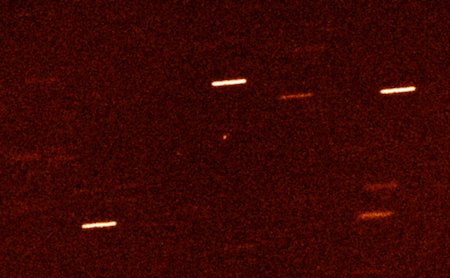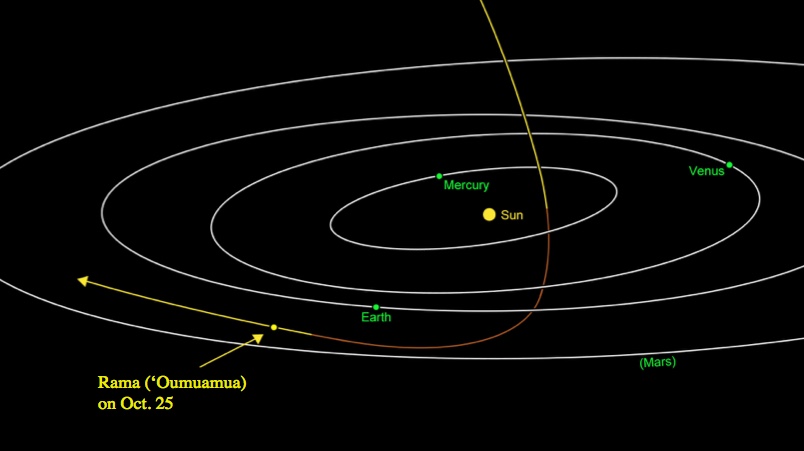Physicist: Good news!
On October 19th, for the first time in history, we detected an object inside of our solar system that originated somewhere else. It’s a rock the size of a stadium that passed inside of Mercury’s orbit and is presently on its way back out.
This is basically the plot of Arthur C. Clark’s seminal novel “Rendezvous With Rama” (sans aliens), which is about a thing from space passing really close to the Sun on a hyperbolic orbit before leaving the solar system. The International Astronomical Union has incorrectly chosen the name “ʻOumuamua” for our first known interstellar visitor, rather than the obvious, pronounceable, and generally superior name “Rama“. A rose is a rose is a rose, right up until the IAU gives it a weird name.

That dot in the middle is not from around here. The background stars are streaks because this is a long exposure by a telescope tracking with Rama. Everything we know comes from observations like this, so while we can determine speed and position, we have to estimate size and mass.
We can tell that Rama is new to the neighborhood because it is traveling far too fast to be gravitationally bound to the Sun. When it’s in interstellar space, Rama travels at 26 km/s (with respect to the Sun), which is about how fast other stars in our stellar neighborhood are moving. As it fell toward the inner solar system it gained speed until, at perihelion, it was a quarter of the distance from the Sun as the Earth and was screaming along at nearly 90 km/s. For comparison, once Voyager 1 has shaken the Sun’s gravitational pull, it will be traveling at about 13 km/s through interstellar space.

The path of Rama (or ʻOumuamua if you insist), the first observed interstellar object to pass through the solar system.
We know that Rama is rocky because it’s not producing a tail. Anything with lots of water ice boils when it gets close to the Sun. Rama is distinctly tail-free, which means that it’s an old, cold rock that’s having its first and last Summer for millions or billions of years.
Presumably, Rama is just one of many interstellar objects to pass through our solar system. We’ve been capable of detecting such objects for only a few decades and this one came remarkably close to us (several dozen Moon orbits, which is “close”). If it hadn’t been so nearby, we probably never would have noticed it. So if interstellar visitors are rare, then we are seriously lucky.
It has long been assumed that objects such as Rama should exist. During the early formation of a star system the new planets and moons follow chaotic, often destructive orbits. Not only do the young planetoids slam into each other, but near misses can fling asteroids, moons, and even planets out of a star system entirely. As recently as 1982, we’ve witnessed Jupiter rudely chucking a comet into interstellar space. The main reason things in a mature solar system (such as our own) follow such nice, clean orbits is that almost everything that didn’t stay in its own lane met a bad end a long time ago. So we can expect the interstellar void to be thinly populated by an unimaginable number of rejected asteroids and comets.
This is likely to be Rama’s backstory. It formed somewhere that wasn’t here, and was ejected from its home star system through an impact event or gravitational slingshot. The fact that it isn’t presently icy means that, for one reason or another, it spent enough time close to its parent star for all of its ice to boil off. It could be a very old comet or a native of an inner solar system. If we bothered to send a probe to catch up with it, we would be able to gain a lot of insight into the ancient chemical history of another star system. It’s been drifting around for so long that it may be impossible to say which star it calls home, but just knowing how another solar system might be different is a big deal. Fortunately, the movement of things in space is extremely predictable, so we’re not going to lose track of Rama anytime soon. Unfortunately, we’d need a rocket about twice as fast as New Horizons (the fastest rocket to date) to catch up with it.
Totally swinging wide: the existence of Rama gives a little more credence to the idea of lithopanspermia, the idea that life might travel between stars embedded in rocks. It has already been shown that some microbial life is perfectly happy in the cold, irradiated vacuum of space, and can even survive the massive accelerations involved in both ejection from, and falling onto, planetary surfaces. What hasn’t been shown (until now) is that those interstellar rocks exist at all. Spotting Rama in the sky is akin to living your whole life on a remote Pacific Island and seeing a (probably empty) boat for the first time. Exciting stuff!
The picture of Rama itself is from here.
The picture of Rama’s trajectory (slightly altered) is from here.
The blender picture is from here.








Interesting! Appreciate the post.
“Rama travels at 26 km/s with respect to the Sun” These speeds I find somewhat confusing. Doesn’t the earth travel at about 30 km/s with respect to the sun? I think the sun travels at about 240 km per second, with respect to the center of our galaxy and we are roughly 2/3 out, on a spiral arm. If earth was forced into a dramatic elliptical orbit 1/4 distance from the sun, 90 km/s does not seem too unreasonable.
@David
It’s not head and shoulders faster than anything else that’s around, merely fast enough to escape and never come back. We have to specify “with respect to the Sun” because the Sun is the closest thing we’ve got to a “stationary” perspective in the solar system. Everything else is moving in circles around the Sun (so Earth will be moving 30 km/s in some direction one day, and 30 km/s in the opposite direction six months later).
Things speed up a lot as they fall toward the Sun, so there’s no single speed to quote. The best you can do is talk about how fast it’s moving when it’s very, very far away, and that speed is 26 km/s.
My intuition has often been proven correct. Eight hundred years ago we thought the world was flat. Today we believe that our universe is flat.
I do not. I suspect that it is an immense bubble. Our universe exists on its surface and it is so large that our observable universe seems to be flat.
I find this more believable that the possibility that our universe is nearly flat and just ‘ends’ somewhere, this side of infinity.
P.S. If the universe does turn out to be a bubble, consider what that implies about the Big Bang. What would you expect would occur when the matter from a bang at one pole reached the opposite pole?
At a minimum this is a rather interesting possibility … both difficult to prove or disprove.
I am confused. Oumuamua is said to have picked up speed with respect to the Sun, as a result of this encounter with our Solar System. How, exactly? If I understand things correctly, a slingshot maneuver with a planet would allow it to gain speed wrt the Sun, but one with the Sun itself would not. The Oberth maneuver would allow it – but propulsion is required. So, how is it pulling it off? Unless what is meant is that it is gaining speed as it falls in the gravitational well of the Sun, but will lose the gained speed when climbing out of it.
The assertion above is true only in the case where the Object is in a continual loop around the Sun. In that case, the gravitational forces pushing the Object toward the Sun as it approaches it, are roughly equal to those pushing them away from one another. When the two balance one another, so that the speed of the Object is roughly the same each time it reaches the point farthest from the Sun, the cycle repeats itself.
The relatively small number of Objects orbiting our Sun today are the survivors that did not collide with some larger object eons ago. Qumuamua only entered our solar system a relatively short time ago and the chance that such an Object would attain a stable orbit around our Sun are rather slim.
To see why this is so, consider the simplest case where the path of an Object might precisely intersect the path of our Sun, such that the two paths were at right-angles to one another. The Object might reach the point where the paths intersect, either before or after the Sun reached that same point, or the two could collide. The case of a collision is of no interest in this discussion.
When the Object crosses the Sun’s path and it is relatively close to the Sun, the gravitational forces exerted during their approach would roughly equal those exerted while they moved away from one another, When the Object crosses the Sun’s path before the Sun reaches the intersection point of their paths, the Sun’s gravitational forces on the Object before it crosses the Sun’s path will be less than those exerted after it passes that point.
Similarly when the Object crosses the Sun’s path after the Sun reaches the intersection point of their paths, the Sun’s gravitational forces on the Object before it crosses the Sun’s path will be greater than those exerted after it passes that point. NASA uses this net increase in speed to help propel satellites into deep space.
Pingback: Q: How hard is it to build a space elevator? What’s the point? | Ask a Mathematician / Ask a Physicist
Science is not always correct. A = B = C. However, A may be incorrect. Never assume.